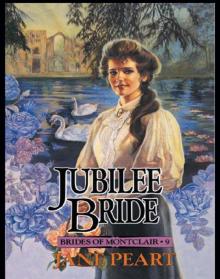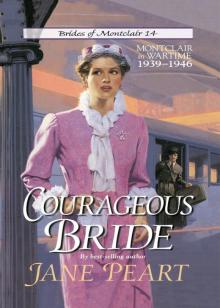- Home
- Jane Peart
A Montclair Homecoming Page 3
A Montclair Homecoming Read online
Page 3
Sylvia then informed her she would have to go to security to get her official name tag, which would permit her access within the hospital.
That accomplished, Joy came back on fourth and stopped at the nurses’ station. She started to introduce herself and explain that she was there to measure the panels in the solarium, but did not get far. A tall, gorgeous redhead, whose uniform could not hide a stunning figure, smiled and said, “Oh, we know who you are. You’re famous! An artiste in our midst! What can I do you for?”
“Well,” Joy began, a little taken aback, “I just thought that since I’ll be here every day, I ought to—” She paused. “Today I’m just going to measure the panels, figure out what basic paints I need, that kind of thing.”
“No problem. I see you got your badge. Come on, I’ll take you in and you can get started. Come and go, feel free. By the way, I’m Ginny Stratton.” She opened the hinged half-door and came out from behind the counter and led the way down the corridor to the visitors’ solarium.
On the way Ginny asked, “So how’re you going about this?”
When Joy explained her plan to find models among the staff and patients, Ginny gave her a skeptical glance. “I don’t think you’re going to find any saints around here for your Bible panels.”
“I’m not looking for saints, Ginny. Sometimes saints have the most unlikely appearances. Looks can be deceiving. Like in that old movie The Portrait of Dorian Gray. What I’m looking for are real people, just like the people Jesus dealt with. Real people to whom extraordinary things happened.”
Ginny just nodded and made no comment. Joy got out her retractable tape measure and started measuring the spaces between the windows where the panels would go.
“Would you like a cup of coffee?” Ginny asked. “We have our own in the nurses’ lounge—good stuff, not like the poison served in the cafeteria.”
“Thanks, that sounds great.” Joy went on measuring.
When Ginny came back, she brought two cinnamon buns along with two mugs of steaming coffee. They sat down to drink it. From her vantage point Joy had a good view of the elevator, and just then she watched it open and saw the young woman who had been on the selection committee emerge. Joy was curious about who she was and why she had served on such an influential body. Was she a doctor or an administrator or some other member of the staff? She wore no uniform but was dressed in a smart-looking pantsuit. As Joy watched, she stopped at the nurses’ station and spoke to a couple of the women there. There was a ripple of laughter at something she said. Joy turned to Ginny. “Who is that lady?”
Ginny glanced in the direction Joy was looking. “That’s Sister Mary Hope. She’s one of the chaplains. Works out of the pastoral care department.”
“Sister Mary Hope. A nun?” Joy did a double take. The woman was about thirty, slim and attractive, with shiny brown hair stylishly cut. “She sure doesn’t look like a nun.”
“Aren’t you the one who just said looks can be deceiving?” Ginny teased. “She was an airline flight attendant before she became a nun. All the things that made her good at that job make her right for this one. You ought to get to know her. I’m sure you’d like her. In fact,”—Ginny raised her eyebrows— “you two probably have a lot in common.”
Joy had never been told she had nunlike qualities. But she let the remark go unchallenged. Ginny must have meant something else.
There wasn’t time for more discussion about her, because Sister Mary Hope was coming toward the solarium. She greeted Joy with a radiant smile. “I’m so glad to see you. I was praying that your work would be chosen for the mural. It had a certain special quality about it that I noticed right away.”
“Thank you.” Joy felt her face grow warm with the sincerity of the compliment.
“Just wanted to welcome you to Good Samaritan and wish you good luck with the mural and God bless.” Then with a wave of her hand she left.
“That was awfully nice of her, wasn’t it?” Joy said, feeling humble.
“Sister Mary Hope’s the greatest.” Ginny jerked her head in the direction of the departing figure. “She visits with patients as well as their families. Sister Mary Hope is an expert in dealing with people’s worries, problems, panic. Techniques she used to apply to the fear of flying now go to the fear of dying.” Ginny laughed, then said, “Well, it’s about time for doctors’ rounds, and I’d better be at my post when they come in, especially Dr. Wallace.” Ginny affected a deep shudder. “The ogre.” With a wry smile she collected their mugs and paper napkins, saying, “See you around, Joy.”
Joy spent the rest of the day measuring, making a list of supplies she would need, jotting down notes.
The following week she prepared the panel walls for painting. It was hard work and tedious. She had to fine sand, then apply two coats of primer, then add a neutral undercoat on which she could begin chalking in the background and figures.
From the beginning the project had enthusiastic support from the staff on the fourth floor, as well as from ambulatory patients and those in wheelchairs. Family and friends who were visiting stopped to ask about what she was doing.
From the very first day Joy searched for models. She found herself looking at people in an entirely different way, fitting faces to the biblical personalities she intended to use in the panels, searching for an extra quality. She felt like a casting director selecting characters for a play. Possibilities were everywhere, in the people she saw every day going about their work, in the ambulatory patients who roamed the halls or found their way to the deck just outside the solarium, or in the people in wheelchairs, hovering curiously a few feet away from where she was doing the primary painting. Joy always had her sketchbook at hand—ready, if the subject was willing, to make some sketches.
Almost every day Ginny joined her with coffee and sweet rolls, some juice, or a candy bar. “Found your models yet?” was her usual question.
“Not yet. Unless you want to pose?”
“Me?” Ginny exclaimed. “In a biblical role? Maybe the woman at the well,” she said with some irony.
Joy glanced at Ginny. Evidently, Ginny knew her Bible.
Ginny caught the look of surprise and shrugged. “I was raised in a Christian home,” she said nonchalantly, adding, “Not so you could tell it now. I mean, we practically lived in church. In the little town where I grew up, there wasn’t much else to do. Twice on Sundays, and Wednesday night prayer meeting. When I went away to nurses’ training was the first time I realized people did anything else.”
Joy saw something pass over Ginny’s face—an expression of sadness or regret?
Then Ginny quickly changed the subject. “Which panel are you going to do first?”
“I need a little girl, Jarius’s daughter. I thought I could ask Dr. Braden if any of her patients are in the hospital.”
Ginny frowned. “Well, you don’t want one who looks too sick, do you? I mean, didn’t Jesus raise her from the dead?” She paused before rushing on to suggest that Joy talk to the head nurse in pediatrics.
It was from Ginny that Joy learned that the hospital world was like a small town. Gossip circulated on a well-oiled “hot line.” Ginny knew everyone and everything about most of the members of the staff. She had her dislikes as well as her favorites. Sister Mary Hope was one of her favorites. One day while Ginny was watching Joy work, she told her, “Patients who are depressed are her specialty. The newest medical methods, like drugs and painkillers, don’t always work. That’s where Sister Mary Hope and her pals come in.”
“And does her method work?”
“Surprisingly, more often than not it does.” Ginny raised her eyebrows. “Maybe I should try it myself.”
“Don’t tell me you are ever depressed?” Joy exclaimed, thinking anyone as pretty and self-assured as Ginny had nothing to be depressed about.
“If I were into self-diagnosis, I’d classify myself as close to being clinically depressed most of the time,” Ginny commented dryly.
“You?”
“Yes, me.” Ginny made a comic face. “Don’t let this clown’s mask fool you.”
“But Ginny—,” protested Joy, ready to go into her “power of positive thinking” mode.
“I don’t want to disillusion you, honey,” Ginny interrupted, “but I have plenty to be depressed about, if you only knew.”
Whatever more Ginny might have said was interrupted by the PA system’s page echoing down the hall: “Dr. Montrose, Dr. Gayle Montrose, please report to pediatrics.”
Startled, Joy stood still, paintbrush in one hand, holding up her other hand to quiet Ginny. Joy tipped her head to one side, listening to the page again. Dr. Montrose! Her name. Not an everyday sort of name. If there was a doctor in this hospital with the same name, she would like to meet him.
“Listen, Ginny, they’re paging a Dr. Montrose. Do you know who that is?”
“Yes, certainly. She’s a pediatric oncologist. Just been here a few months.”
“She? Dr. Montrose is a woman?” Joy was surprised and excited by this information.
“Yes, and very serious—all business. No kidding around. She’s up here on fourth because one of her patients is being operated on. She’ll be here all night if necessary. Totally dedicated.” Ginny glanced at Joy. “Want her to pose for your mural?”
“Maybe. I don’t know. She might be right for one of them. I can’t tell until I meet her.”
“She’s quite beautiful, I think,” Ginny said. “But I doubt if she’d consent to doing anything as frivolous—if you’ll excuse the term—as being a model for a painting. Life is real, life is earnest for Dr. Montrose…and the grave is definitely not its goal. Her patients don’t die, if she has anything to say about it.”
chapter
5
A FEW DAYS AFTER Joy learned that there was a doctor at Good Samaritan Hospital who shared her name, Dr. Braden confirmed Ginny’s comments about Dr. Montrose. Joy had gone down to the pediatric floor to study some of the children, searching for her Jarius’s daughter. As she came out of the elevator, she encountered Dr. Braden. After an exchange of greetings, questions about the progress of the mural and about Joy’s reason for coming to Dr. Braden’s department, Joy asked her about Dr. Montrose.
“Gayle? She’s wonderful. I’ve never seen a more devoted resident. She has no sense of time. Stays working until all hours. Goes the extra mile constantly for her patients.” Dr. Braden halted, bit her lower lip as if considering whether to say more. “The only fault I find with her is that she absolutely refuses to acknowledge that anyone could die. Her patients must recover. A doctor eventually has to learn that in spite of all we can do, patients do die. Even children. And that of course is the hardest lesson of all, one Dr. Montrose has yet to accept.”
Just then Dr. Braden looked past Joy and smiled, saying, “Here she comes now. I’ll introduce you.”
Joy turned in time to see a tall, willowy young woman walking toward them, wearing a long white lab coat. The fact that she was an African-American struck Joy only after her first impression of breathtaking beauty. Her skin was the color of creamed coffee, her black hair worn severely pulled back into a knot at the nape of a graceful neck. She had wide, dark eyes, a nose with slightly flared nostrils, and a full, curved mouth. She certainly fit Ginny’s description. Dr. Montrose was striking in appearance.
When Jean introduced them, Joy thought she saw something curious flicker in Dr. Montrose’s eyes. However, the woman paid close attention to Dr. Braden’s explanation of why Joy was on their floor.
“Could you show Joy around?” Dr. Braden asked her. “Maybe even suggest a child for the panel she has in mind?”
Joy noticed a slight hesitation. Then Dr. Montrose said, “I’m just going off duty, Dr. Braden. Would tomorrow be all right?” She glanced at Joy.
“Of course. Any time that’s suitable for you, Doctor,” Joy said quickly.
“Fine. If you’ll come down around ten tomorrow morning, I’ll have made my rounds and then I’ll be free.”
Back on fourth Joy sought out Ginny and asked her to go to the cafeteria for coffee. As soon as they were seated, Joy asked, “Why didn’t you tell me Dr. Montrose was black?”
“Why, would it have made a difference?” Ginny’s lovely hazel eyes narrowed.
“No, I was just surprised. I guess I thought that with our having the same last name, she might be a long-lost relative. You see, I don’t know anything about my relatives—at least my father’s relatives.”
Ginny’s cup raised to her lips, halted. “Why not? Are you adopted?”
“No, but I never knew my father. He died before I was born. He was a navy helicopter pilot and was killed in Vietnam. He and my mother met in San Diego when he was in training. They married there and then he went overseas. My mother was only a few months pregnant with me.”
“Sorry. That must have been rough.”
“Yes, on my mother of course. But she remarried when I was three, and we moved to Ohio. All I knew of my father was a photograph of him in his uniform. When my mother died when I was eleven, I found it among her things. I don’t remember my mother talking about him. I guess she wanted me to think of Steve as my dad.”
“And did you?”
Joy shook her head. “Not really. He was gone a lot, traveling in his work. Then after Mom died, I lived with some of his relatives for a while, then was sent to live with Molly Ellis, a distant cousin of my mother’s. When my stepdad remarried, he just sort of dropped out of my life. Maybe it was my fault. I was a self-centered teenager—” Joy shrugged.
“I’ve got so many relations, I’ve lost count!” Ginny laughed. “So don’t feel too bad, Joy. There’s something to be said for being an orphan. Nobody to tell you what to do or what not to do, nobody to give you unsolicited advice or unwanted criticism. Most of my kin think I’ve gone wildly astray and don’t mince words telling me so.”
“It’s funny, but hearing her name over the pager, then meeting her, made me realize how much I really have missed, not having a family. Maybe we do have some connection. I don’t know, but I’d like to find out.”
“Why don’t you make a date to have lunch with her?” Ginny suggested. “Ask her about her family?”
“Dr. Braden asked her if she would escort me around pediatrics tomorrow. Maybe after that we could go have lunch or at least coffee.”
“Good idea. But be careful. I believe she’s a private sort of person. She might not appreciate you quizzing her,” Ginny warned.
“Oh, I won’t. I’ll just tell her about me. I liked her. I’d like to get to know her.”
Joy went back to work and worked steadily for most of the next two hours. All at once she felt very hungry and realized she hadn’t taken time for lunch. When she stood up, she felt woozy and knew she had better eat something.
She took the elevator down to the lobby and found a vending machine. She pushed in her change, and a candy bar tumbled down into the little metal retainer. Then she got a soda from the soft drink dispenser next to it.
She had just unwrapped her candy bar and taken a bite with a sip of her cola when a stern voice behind her asked, “You know that stuff will kill you, don’t you?”
Nearly choking, she whirled around. Dr. Wallace stood there, hands on his hips, glaring at her. He pointed to her candy bar and the soda can she was holding and shook his head. “That stuff knocks off laboratory rats by the dozens. You should take better care of your health.”
Joy saw a twinkle in his eyes and a hint of a smile. She put on a hangdog look. “Caught in the act! I plead guilty. But there was no yogurt or granola in the vending machines. Maybe I should put in a demand for healthier snacks. Or is there such a thing as a suggestion box here?”
“I don’t know. I’ll bring it up at the next staff meeting,” he promised. He remained there for a minute as though he wanted to say something else. “How’s the mural coming along?”
“Well, I’m only doing the undercoating so far. But I thi
nk it will be fine—I hope so.”
“Good.” With a brisk nod he turned and headed for the elevator.
Joy looked after him. Those were the first words she’d exchanged with Dr. Wallace since she’d begun work at the hospital. She had seen him once or twice, striding purposefully from the O.R. or toward recovery, looking straight ahead. She had rather hoped to continue avoiding him, feeling that maybe he resented her because over his objections her theme had been approved for the mural.
However, he hadn’t seemed that hostile or formidable just now. Joy recalled Ginny’s reminder that appearances can be deceiving. Maybe she had been wrong about Dr. Wallace as well.
Joy’s first two weeks at Good Samaritan had certainly been full of interesting meetings, unexpected encounters, and strange coincidences.
chapter
6
JOY WAS LOOKING FORWARD to Dr. Montrose’s promised tour of pediatrics. The minute Joy stepped off the elevator, she was conscious of being in a different environment from that on the other floors. There was something in the air that was tangible, lighter somehow. Why should that be? The place was full of sick children, some of them seriously so. That’s what Drs. Braden and Montrose dealt with every day.
Joy walked slowly down the corridor, past rooms where the doors were open. Nurses were busy adjusting IVs, administering medication. Most rooms had four beds. The walls were painted soft yellow and hung with colorful posters. Bunches of bright balloons floated from door frames, and the staff behind the nurses’ station wore flowered smocks instead of uniforms. Joy looked down the hall into what appeared to be a large playroom. There children were gathered around a pretty young woman who was telling them a story, using hand puppets. Although the children wore bathrobes and of course no one was running about, shouting boisterously, the scene resembled a kindergarten. In spite of the fact that some of the children had IV poles dangling above their wheelchairs, and some little heads were bald from the effects of treatment, the atmosphere was cheerful.

 Hero's Bride
Hero's Bride Daring Bride
Daring Bride Runaway Heart
Runaway Heart Promise of the Valley
Promise of the Valley Gallant Bride
Gallant Bride The Pledge, Value
The Pledge, Value Senator's Bride
Senator's Bride Valiant Bride
Valiant Bride Shadow Bride
Shadow Bride Destiny's Bride
Destiny's Bride A Tangled Web
A Tangled Web Folly's Bride
Folly's Bride The Promise
The Promise Mirror Bride
Mirror Bride Jubilee Bride
Jubilee Bride Yankee Bride / Rebel Bride
Yankee Bride / Rebel Bride A Montclair Homecoming
A Montclair Homecoming Fortune's Bride
Fortune's Bride Undaunted Spirit
Undaunted Spirit Love Takes Flight
Love Takes Flight The Risk of Loving
The Risk of Loving The Pattern
The Pattern Courageous Bride
Courageous Bride